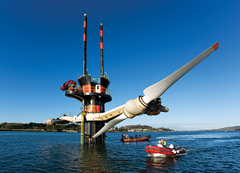Alan Whitehead MP: Invest now to deliver marine success
 A high level of initial investment in marine renewables is needed to bridge the gap between prototypes and commercial deployment, according to Alan Whitehead. Renewable UK’s Politician of the Year talks to Peter Cheney.
A high level of initial investment in marine renewables is needed to bridge the gap between prototypes and commercial deployment, according to Alan Whitehead. Renewable UK’s Politician of the Year talks to Peter Cheney.
Strong investment for marine renewables in this decade is absolutely essential to deliver the technology’s long-term benefits, Alan Whitehead states.
The Labour MP for Southampton Test has been a member of the Energy and Climate Change Committee since 2009. He chairs the cross-party Parliamentary Renewable and Sustainable Energy Group and was named as Renewable UK’s Politician of the Year in June.
During Whitehead’s time as leader of Southampton City Council (1984-1992), the council developed a “very substantial” geothermal system, which continues to work today, “and that certainly sparked my abiding interest in the efficacy of renewables.” He adds that Southampton University’s renewable energy development group has been looking at tidal and wave technology over a number of years.
Whitehead comments: “As far as marine is concerned, the key problem I think at the moment is getting over what you might call the ‘valley of death’ between a very good functioning prototype and a commercially functioning array, and that, as indeed is the case with a number of other renewable areas, requires a lot of upfront investment.”
Renewable energy, he notes, is “precisely the other way round” from conventional energy in that “you put the money in first and, after that, the fuel is pretty much free.” Once the funding becomes available, the next question is the extent to which renewables will be “supported and underwritten by government” so that it can get to commercial deployment.
Current funds for this work are “probably insufficient” but he only envisages state support being necessary in the early stages as “certainly all the indications are that once you can deploy at scale, the costs come down pretty rapidly.”
Whitehead remarks: “The UK actually has a world lead at the moment in both tidal current and wave and I wouldn’t like to see us throw it away because we lack a few pounds in the first instance, so it’s a crucial time.”
Addressing the Northern Ireland Offshore Renewables Seminar, the MP commended Northern Ireland on establishing the UK’s first working commercial tidal stream turbine (in Strangford Lough).
Ambitiously, Northern Ireland’s aim of generating 300GW of tidal stream by 2020 equals the target of 300GW for England and Wales despite its coastline being twenty times shorter.
At his suggestion, the Energy and Climate Change Committee had carried out an inquiry into the potential, progress and challenges for UK marine renewable energy technologies, which reported in February 2012. The inquiry looked at tidal stream and wave but not impoundment or barrage technology as these were already mature.
 The Carbon Trust has estimated wave and tidal power could supply 20 per cent of present UK electricity demand and also (by 2050) reduce CO2 emissions from electricity generation by a third. However, Whitehead explained that the industry is “very immature” and the UK’s lead depends on having seven out of the world’s eight deployed machines.
The Carbon Trust has estimated wave and tidal power could supply 20 per cent of present UK electricity demand and also (by 2050) reduce CO2 emissions from electricity generation by a third. However, Whitehead explained that the industry is “very immature” and the UK’s lead depends on having seven out of the world’s eight deployed machines.
He sees no “closure” in the industry on which overall technologies or sub-technologies will lead the sector’s development. There are around six leaders in wave and tidal technology but “frankly a lot of blokes in sheds demonstrating very clever devices which work very well in a tank but have yet to prove themselves in open water.”
The cost of commercial deployment is well beyond the current developers’ capacity and would also result in high initial generating costs: probably 29-33p per KWh for the first tidal farms and 38-48p per KWh for the first wave farms (compared to 9-10.5p per KWh for onshore wind).
The Labour Government set up a £50 million marine renewables deployment fund but uptake was very low “partly because it was a deployment fund at a point where the industry was not ready for deployment.” The Coalition Government has replaced this with a £20 million innovation fund, which is supplemented by the Scottish Government’s £18 million deployment fund. The EU New Entrants Reserve is another possible source but industry sources are also concerned that there will be too many funding sources.
Substantial reductions in energy production costs, in his view, will only come with widespread array deployment. In tidal energy, a large scale roll-out by 2020 could reduce costs from 29-33p per KWh to 9-18p per KWh, with potential reductions (possibly to 7-10p per KWh) by 2030. This predicted trend is based on the cost curve for solar power and onshore and offshore wind but the current level of funding, he claims, will not achieve this change.
Prior to DECC’s banding review, all marine technologies received two ROCs per MWh. After the Scottish Government offered five ROCs for wave and three ROCs for tidal stream, the UK Government increased its support to five ROCs for both technologies (up to 30MW per deployment).
This was “good news in principle” but again, he expected “virtually no take-up” before 31 March 2017, when ROCs will be replaced by contracts for difference. It was unclear how contracts for difference will vary across different technologies or how the Treasury’s ‘levy cap’ mechanism will affect this form of support.
In conclusion, Whitehead saw “enormous potential” in marine renewables but doubted whether they would be “widely deployed” before the 2030s. Government policy would determine whether that the date of that deployment would be brought forward or pushed back.
UK marine renewables: Whitehead’s assessment
| Positives | Negatives |
| Europe’s largest wave and tidal resource | Immaturity |
| World leader in technology | No arrays |
| Potential capacity: 40-50Twh per year | Competing technologies |
| Potential market share: £76 billion out of a £340 billion market in 2050 | Sea demonstration for full scale prototype costs £10-30 million |
| Potential direct jobs: 10,000 by 2020 and up to 68,000 by 2050 | Deploying commercial array costs £30 -100 million |





